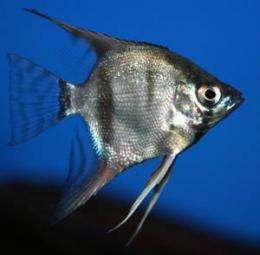Can angelfish do math?

(PhysOrg.com) -- Beauty and brains don't often come together. But angelfish, a species prized by pet fish owners for its bright good looks, might possess math skills, show studies coauthored by Professor Robert Gerlai of University of Toronto Mississauga's Department of Psychology and Professor Luis Gomez-Laplaza of the University of Oviedo in Spain.
Published in the journal Animal Cognition, the first study examined the tendency of angelfish to seek protection in an unfamiliar environment by joining a group (or shoal) of other angelfish.
Known as shoaling, this behaviour helps fish forage more efficiently. It also helps them protect against predators, which may be confused by the size of the shoal.
Larger shoals, however, do come at a cost. Competition for food increases with shoal size, as does intra-shoal aggression.
To determine how angelfish discriminate between different shoal sizes, Gerlai and Gomez-Laplaza placed a single test fish in a test tank flanked by a "stimulus" tank on either side. Each stimulus tank contained a large shoal that varied from the other both in terms of ratios and in absolute numbers of fish.
The researchers then recorded where the test fish swam.
Their results confirmed that angelfish exhibited a preference for larger shoals, but not in terms of the absolute difference in number of fish. Rather, the preference depended on a ratio of shoal sizes. When presented with large shoals, the test angelfish showed a preference for a shoal that was at least 1.8 times larger than the other. Once the ratio of one shoal to the other was below 1.8:1, the test angelfish stopped showing a preference.
"We're not really sure at this point [why they stop at that ratio]," said Gerlai in an email interview.
"It is possible that there is an upper threshold of abilities beyond which the angelfish brain cannot perform. But it is also possible that the angelfish in their natural habitat did not have to solve problems [at this level]."
Gerlai is quick to point out that the study does not prove angelfish can count. Instead, because the fish showed a preference based on ratio and not in terms of absolute numbers, "one can conclude that angelfish did not count the shoal members and did not subtract one value from the other (...) [They] probably perceived some sort of quantitative characteristic of the shoals they were comparing. For example, larger shoals occupy a larger area in the water, or reflect more light."
However, in a second paper (yet to be published) in which Gerlai and Gomez-Laplaza tested how angelfish behaved when the shoals to be compared were small, results showed that angelfish could go below the ratio of 1.8.
In fact, "they could distinguish shoals differing in relative ratio of 1.5, that is, they could tell a shoal of three versus two fish apart," said Gerlai.
Provided by University of Toronto Mississauga
















